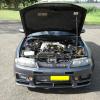Twincharging Cut Off?
Announcements
-
Similar Content
-
Latest Posts
-
No, you don't want to plug the vacuum line, as that will turn that side of the booster into an air spring and probably make it feel worse. I'm not saying that the GTR master itself doesn't need a booster. I haven't paid attention to the GTR one to know what size it is cf the non-GTR ones. But when you think about it - they have to do the same job, which is to move a little slave piston a few mm to do what it is supposed to do, and that final action is the same on all the cars. So, it is very unlikely that the GTR MC is any different than the others, because it has the same pedal stroke and the same output requirement. The booster just makes it feel easier. I'd suggest you probably have an actual hydraulic problem. It's totally common on these old shitboxes.
-
Ye, in terms of bolting up the "Conversion" from a GT to a GTT is effectively "Use GTT parts for everything" Except the subframe itself, because you won't want a HICAS/4WS subframe. Remember your ABS system will be different too, thanks to GT being the S15 3 sensor system, instead of the R34 4 sensor system for wheel speed. I do not know how people get this to work given R34 diffs do not have a provision for an ABS sensor (they are on the tone wheels of the axles). I assume***** people use S15 gear/R34NA forever when they realize this - Or they convert it to a rear diff/axles that are R33 style which I presume has the singular speed sensor on the diff itself, but then you have to wire it all in and...and... and...
-
The ones in brackets are the first stages of tightening. I usually aim for the middle of the range. They give a range because it's actually not that critical to hit exactly the right bolt tension. Enough is enough, and too much is too much, and the range given is inside that range. Half of the bolts in the suspension are problematic for putting a torque wrench on anyway, so just get done up to mechanic tight and spanner checked a week later.






Recommended Posts
Create an account or sign in to comment
You need to be a member in order to leave a comment
Create an account
Sign up for a new account in our community. It's easy!
Register a new accountSign in
Already have an account? Sign in here.
Sign In Now